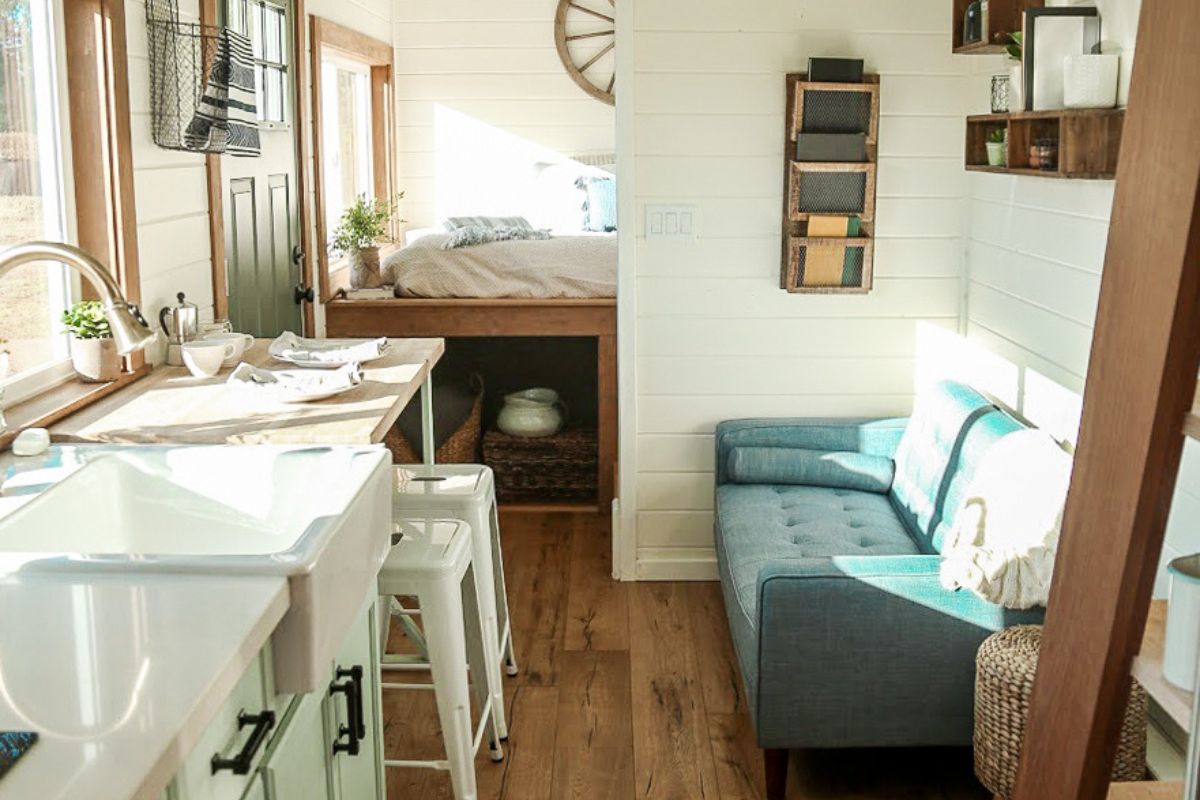Proper insulation keeps your tiny house cozy year-round by minimizing heat loss in winter and retaining cool air in summer. Focus on high R-value insulation materials, like spray foam or rigid foam boards, for maximum efficiency. Guarantee floors, walls, and roofs are well-insulated and sealed to prevent drafts. Consider eco-friendly options for sustainability. While DIY projects offer personal control, professional installation guarantees quality and expertise. Explore more to make informed insulation choices.
Key Takeaways
- Choose insulation with appropriate R-values for your climate to maximize energy efficiency and comfort.
- Use spray foam insulation for superior coverage and air sealing in walls.
- Install rigid foam boards on floors and roofs for excellent thermal resistance.
- Incorporate vapor barriers to prevent moisture damage and maintain insulation effectiveness.
- Consider professional installation for reliable results and compliance with building codes.
Understanding R-Value and Its Importance
When insulating a tiny house, understanding the concept of R-value is crucial. R-value measures how well a material resists heat flow, directly impacting your home's energy efficiency and comfort. The higher the R-value, the better the insulation keeps warmth inside during winter and heat out during summer. In a tiny house, where every inch matters, selecting the right R-value guarantees ideal thermal protection without wasted space.
To determine the appropriate R-value, consider your climate zone. Colder regions require higher R-values for maximum insulation effectiveness. Additionally, be mindful of your tiny house's design—walls, floors, and roofs may need different R-values based on their exposure to the elements. By focusing on R-value, you'll create a cozy, energy-efficient living space year-round.
Choosing the Right Insulation Material
Now that you've grasped the significance of R-value, it's time to focus on selecting the right insulation material for your tiny house. Start with foam board insulation, which offers high R-value per inch and is great for tight spaces. It's lightweight and easy to install but may require additional sealing to avoid air leaks. Consider spray foam insulation for superior coverage and air sealing.

It expands to fill gaps, ensuring a snug fit, but can be more expensive. If you prefer eco-friendly options, wool or cotton insulation are sustainable choices with decent thermal performance. For affordability, fiberglass batt insulation is a classic, though it requires precise installation to achieve its full potential. Evaluate your climate, budget, and preferences when choosing.
Insulating Floors for Maximum Comfort
Although often overlooked, insulating the floors of your tiny house is essential for maintaining a comfortable living environment. You'll want to start by choosing the right insulation material. Rigid foam boards are a popular choice, offering excellent thermal resistance while being easy to install. To guarantee efficiency, seal any gaps to prevent drafts from sneaking in.
Before laying the insulation, inspect the subfloor for moisture issues. A vapor barrier can be a smart addition to keep moisture at bay, protecting your floor insulation from damage. Don't forget the importance of floor coverings; thick carpets or rugs can add an extra layer of warmth and comfort.
Wall Insulation Techniques for Tiny Houses
While maximizing space is key in tiny houses, wall insulation shouldn't be overlooked if you want to guarantee year-round comfort. Start by choosing the right insulation material. Spray foam is popular for its high R-value and air-sealing properties, though it can be pricey. Alternatively, consider rigid foam panels; they're affordable and easy to install. Remember, even small gaps can lead to significant heat loss, so make sure a snug fit.
Next, focus on vapor barriers. They prevent moisture from seeping into walls, which can cause damage. Install them on the interior side in colder climates and the exterior in warmer ones. Finally, don't forget about soundproofing. Insulation materials like mineral wool not only retain heat but also reduce noise, enhancing your tiny home's coziness.
Efficient Roof Insulation Strategies
Proper roof insulation is crucial in tiny houses to maintain an ideal indoor climate and reduce energy costs. Start by selecting the right insulation material, like spray foam or rigid foam boards, which offer great thermal resistance. Make sure you seal every gap to prevent heat loss and drafty air intrusion. Consider a reflective barrier; it can deflect radiant heat during scorching summers, keeping your space cooler.
Don't forget ventilation—it's important to prevent moisture buildup, which can cause mold and damage. Ridge vents or soffit vents are effective solutions. Finally, check for local building codes to guarantee compliance. With a well-insulated roof, you'll enjoy a cozy tiny home all year, making the most of your heating and cooling systems.

The Role of Windows and Doors in Insulation
Windows and doors play a pivotal role in your tiny house's insulation, directly impacting energy efficiency and comfort. Choosing well-insulated options can notably reduce heat loss in winter and keep the interior cool in summer. Double-glazed windows are a great investment, as they offer better thermal resistance than single panes. Make sure door frames are tightly sealed with weatherstripping to prevent drafts.
Don't overlook the importance of proper fitting. Even the best-insulated windows and doors won't perform well if gaps exist. Use caulking to fill any spaces around frames, ensuring a snug fit. Consider energy-efficient models designed specifically for small spaces, as they're optimized for minimal heat exchange. By focusing on these aspects, you'll enhance your tiny home's overall insulation performance.
Handling Moisture and Condensation Issues
Guaranteeing your tiny house is well-insulated doesn't just stop at windows and doors; handling moisture and condensation is also vital for maintaining a comfortable and healthy living environment. Moisture can lead to mold, mildew, and structural damage if not managed properly. Start by installing a vapor barrier on the walls and ceiling to prevent moisture from seeping in.
Proper ventilation is essential—consider using exhaust fans in the kitchen and bathroom to expel humid air. A dehumidifier can also help maintain ideal humidity levels, especially in damp climates. Insulated curtains and blinds can reduce condensation on windows. Regularly check for leaks and seal any gaps. By proactively managing moisture, you'll guarantee your tiny house stays cozy and safe year-round.
Eco-Friendly Insulation Options
When it comes to insulating your tiny house with the planet in mind, eco-friendly options abound. Consider using sheep's wool, which offers excellent thermal performance and naturally regulates humidity. It's sustainable, biodegradable, and even resists mold. Another option is recycled denim insulation. Made from recycled cotton fibers, it's non-toxic and safe to handle without protective gear. If you're after something more innovative, try cork insulation.
Cork is renewable, sound-absorbent, and boasts high insulation properties. For a plant-based choice, look at cellulose insulation, derived from recycled paper. It's cost-effective and has a low environmental impact. Finally, consider hemp insulation, known for its durability and energy efficiency. With these options, you can keep your tiny house cozy while minimizing your ecological footprint.
DIY Insulation Tips and Tricks
Insulating your tiny house yourself can be both rewarding and cost-effective, provided you know a few key tips and tricks. Start by choosing the right insulation material. Fiberglass, foam board, and spray foam are popular DIY choices. Measure your spaces accurately; it's essential for minimizing waste and guaranteeing a snug fit. When installing, focus on sealing gaps.

Use caulk or spray foam to fill small cracks and prevent drafts. Don't overlook the importance of ventilation; it keeps moisture at bay and maintains air quality. Insulate floors, walls, and ceilings for consistent comfort. Use reflective barriers on windows to enhance thermal efficiency. Finally, research local building codes to confirm compliance. With these strategies, you'll create a cozy, energy-efficient tiny home.
Professional Installation vs. DIY: Making the Right Choice
Why choose between professional installation and DIY for insulating your tiny house? Consider your priorities. If you value expertise and efficiency, a professional might be your best bet. They'll guarantee proper materials and techniques, minimizing energy loss. However, it comes at a cost, impacting your budget.
On the flip side, DIY insulation lets you save money and gives you hands-on control. It's a learning opportunity, but mistakes can lead to inefficiency if you're not careful. Assess your skill level and time availability before deciding.
Ultimately, weigh both options against your needs. Do you prefer the assurance of a seasoned pro, or do you relish the challenge of tackling it yourself? Each path has its pros and cons, so choose wisely for cozy, year-round comfort.
Conclusion
By understanding R-value and selecting the right insulation materials, you guarantee your tiny house stays cozy all year. Focus on insulating floors, walls, and roofs effectively to maximize comfort. Don't forget to address moisture and condensation, which can impact insulation performance.
Explore eco-friendly options to align with sustainable living goals. Whether you choose DIY or professional installation, arm yourself with the right knowledge to make the best decision for your home's comfort and efficiency. Stay warm and enjoy your tiny living adventure!






Share: